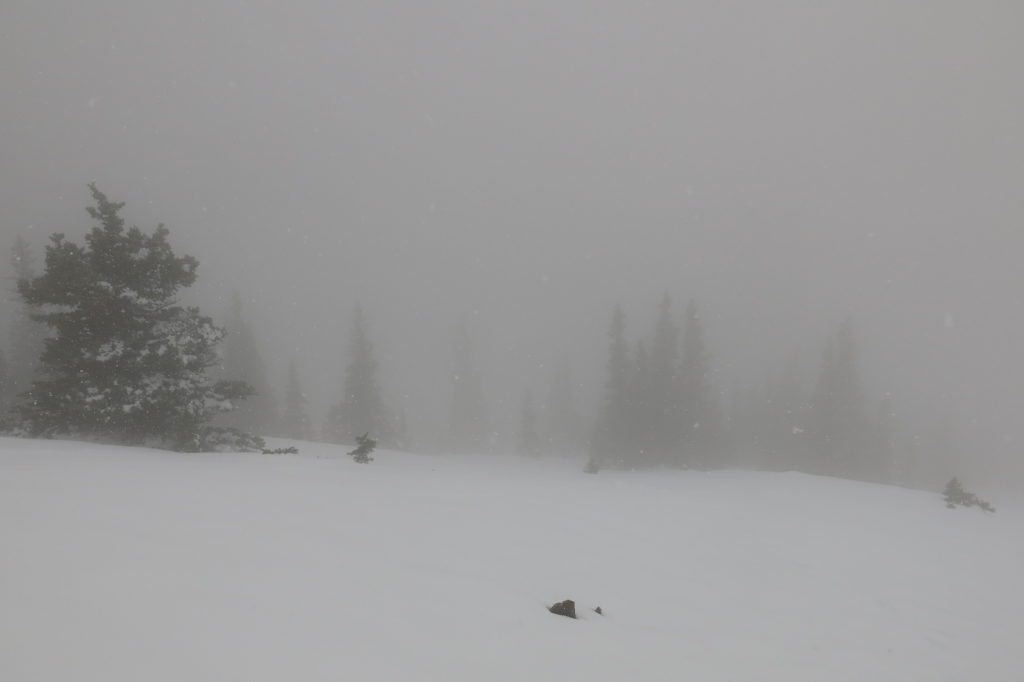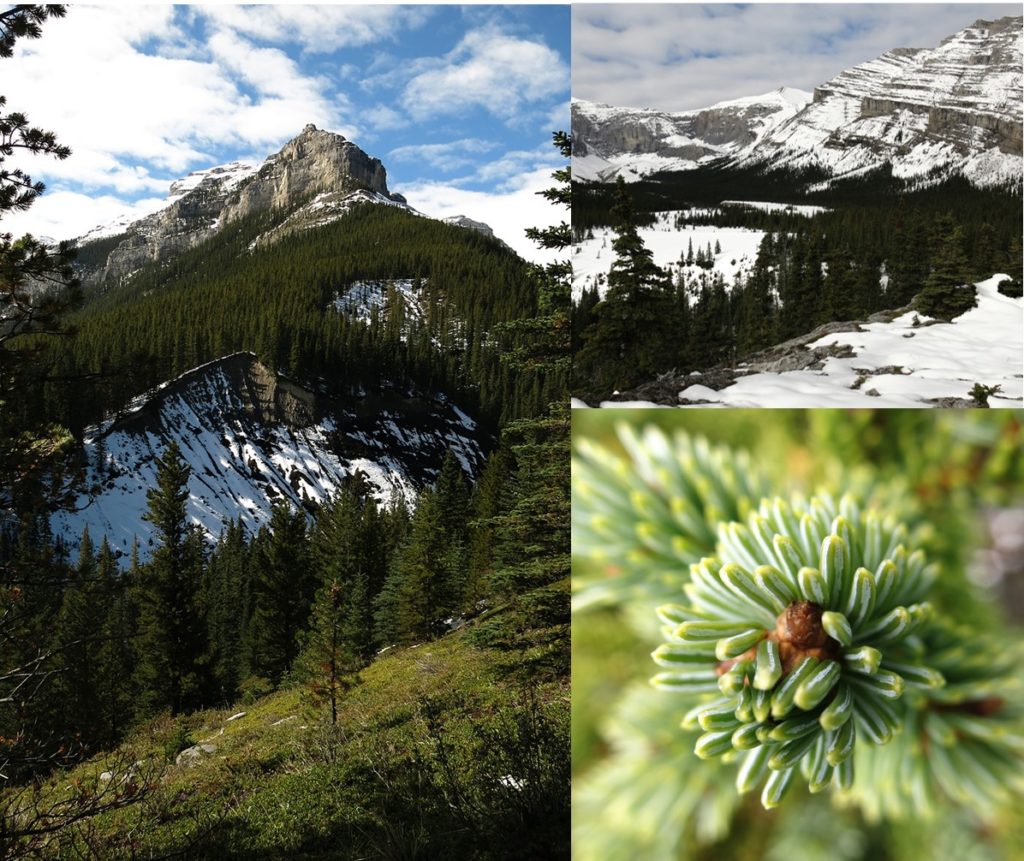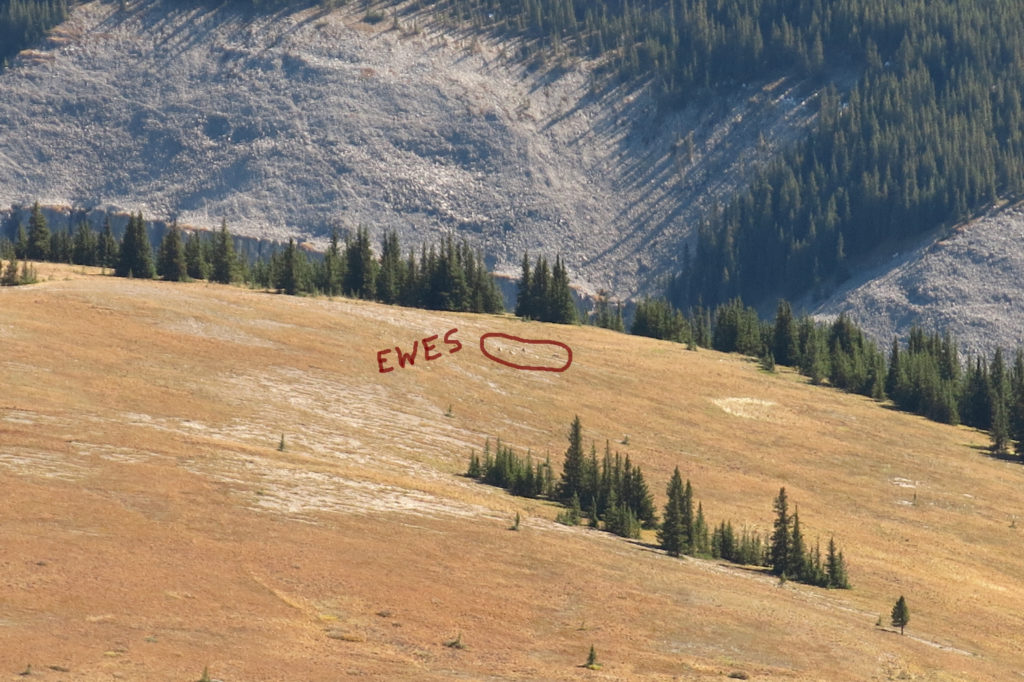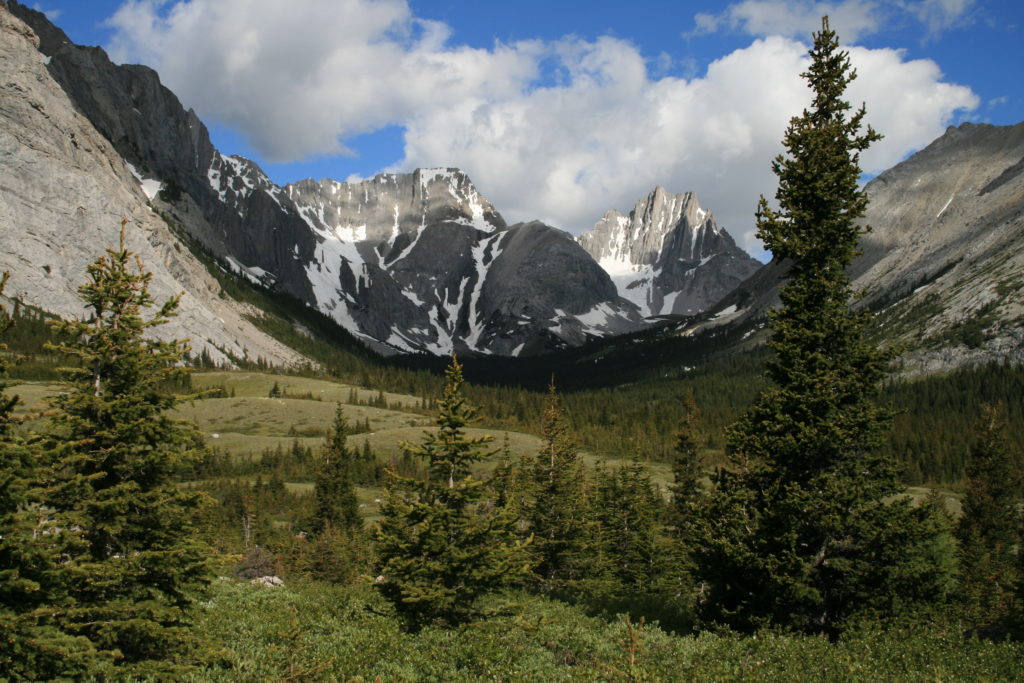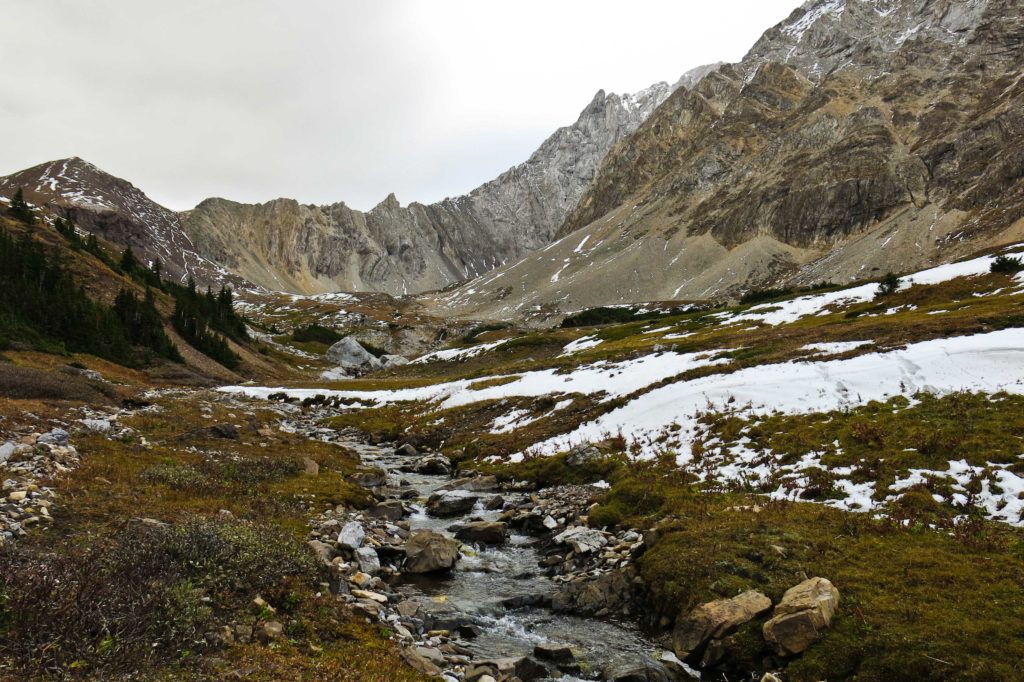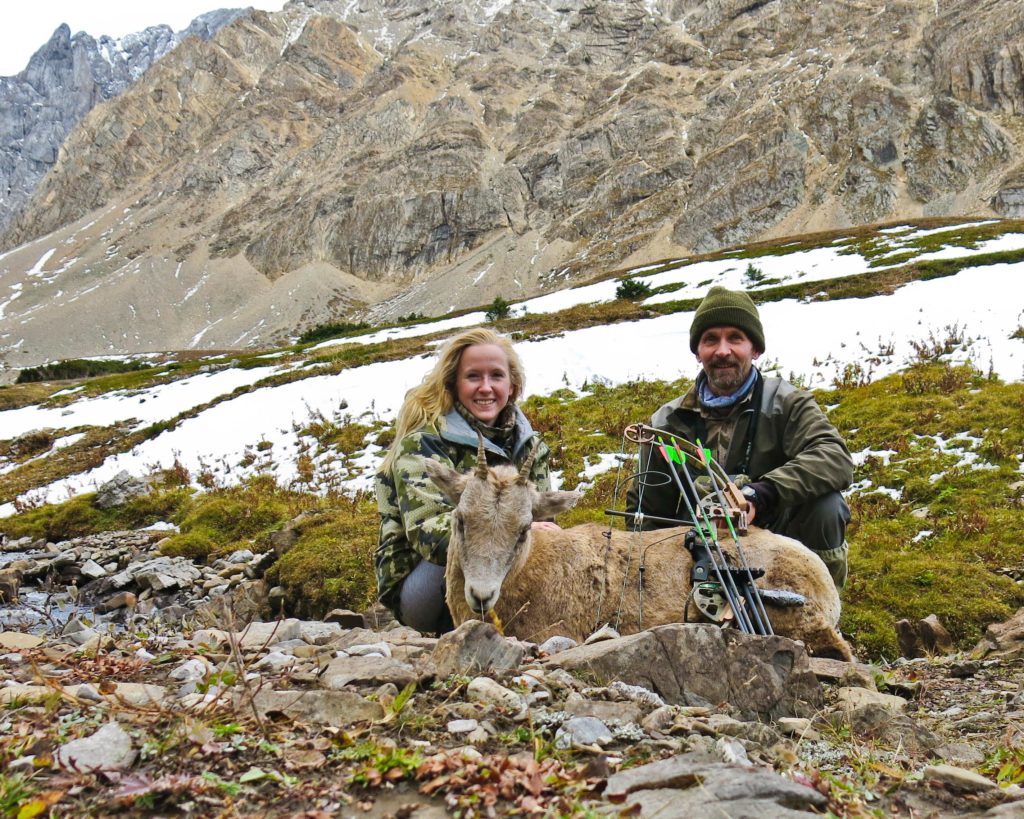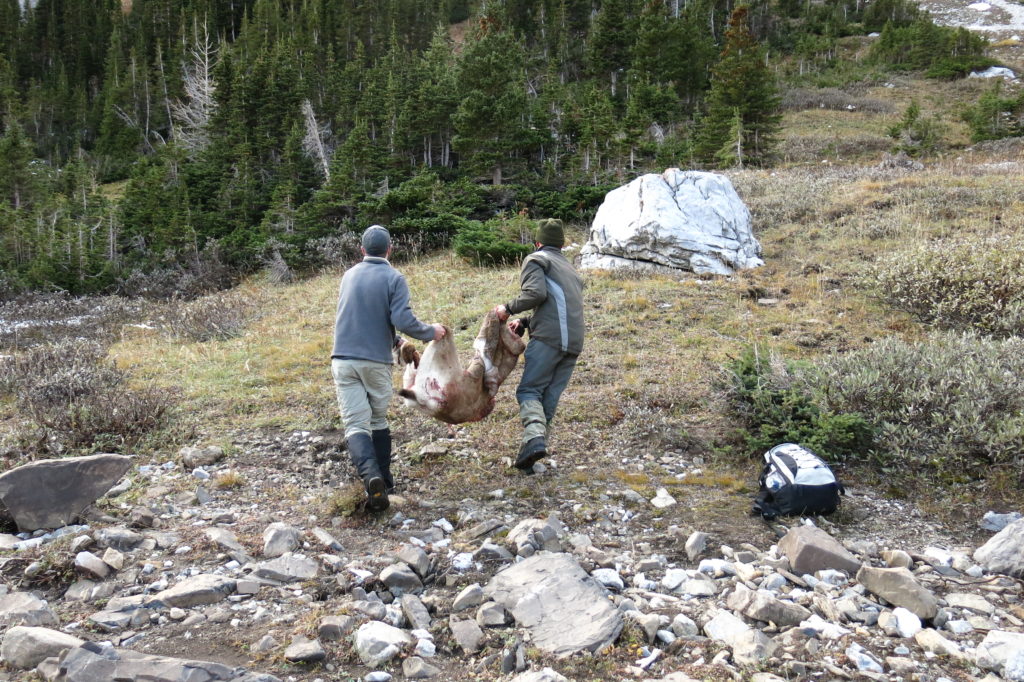November 24, 2013—I was on my fifth day of hunting a special bighorn sheep tag in Cadomin, Alberta. The weather had been terrible, with temperatures around -30C and winds of 60 mph, with gusts up to a whole lot more. We had watched some restlessness come into the rams the previous day, and some had shown up near our perch. That morning we witnessed a small group heading from the protection of the mine to the high country, where the wind had cleared the vegetation of the deep snow that still covered the low lying areas. We climbed hard and met them at the ridge. Chipper, a ram we had been watching the four previous days, with had busted a piece off the tip of his almost 40” left horn, was in the group and our destinies crossed.
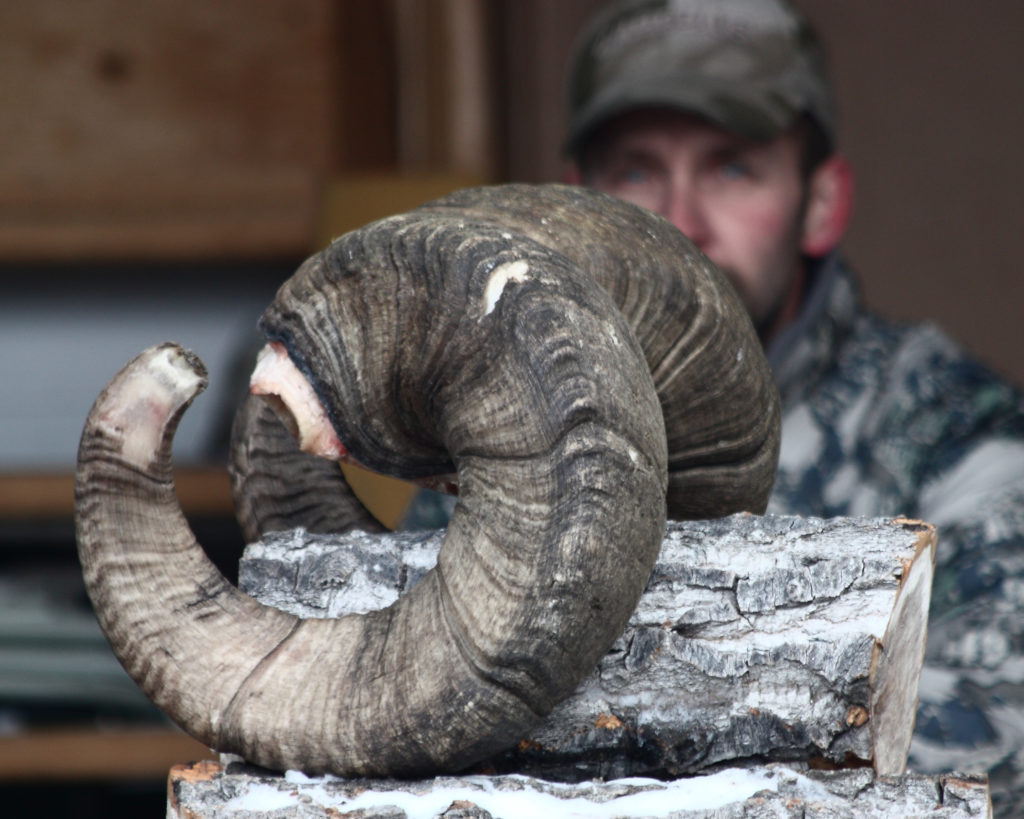
June 2014 — It was once again time to put in for the hunting draws. Regulations in Alberta state that if you have shot a ram, you are out of the game for one year, which means you can’t hunt rams the first season after the one in which you were successful. You can, however, hunt “non-trophy sheep,” or ewes.
Hunting ewes is a topic that can spark some hefty debates amongst hunters. Some argue that ewes make rams and should therefore be left alone, but, the fact is, in Alberta we have not been meeting the ewe quota that had been identified as necessary to keep the sheep numbers in line with the carrying capacity of their ever-degrading range. Fire suppression and increased access have meant that less quality habitat is available to sheep and reducing ewe numbers contributes to keeping things in balance.
I looked at the stats, and there was only one area in which I would be likely to draw with the number of priorities that I had accumulated and it just happened to be the area closest to my home. As luck would have it, I drew the tag. Ewe hunting should be pretty straightforward, right? Whenever you are looking for rams, ewes pop up in your binoculars all the time. During one unsuccessful hunt for their adult male companions, I had a group of 30 graze in front of my tent all night long. To increase the challenge, I decided I would hunt them with the bow.
Bowhunting and I have gone through a few ups and downs, but mostly downs. A friend of mine had given me a Fred Bear bow that she’d stopped using and I worked hard to become proficient with it. I even hunted with it. The year before I had managed to crawl into range of a mule deer twice. The first time I shot over and the second time the string hit the loose sleeve of my oversized winter camo jacket. I don’t know where that arrow went, but it definitely wasn’t into a deer. With my nerves shot, and a big tag like the Cadomin tag in my pocket, I decided to leave the bow at home. Of course the ram presented a perfect broadside shot at 40 yards that I probably could have made, but I hadn’t been about to risk it. This year, however, it was boom or bust. Bowhunt this ewe or go home empty handed.
September 12 — Opening day earlier in September had come with a foot of snow. Many other sheep hunters, mainly those with dreams of taking a ram, had been caught in it as their season started a few days earlier. I had the luxury of waiting out the worst days and made my first climb into the high country when the snow had, at least for the time being, stopped falling.

The day started clear. It didn’t take too long to get above the front basin, a spot where there are “always” ewes, and I found about half a dozen sets of tracks funneling up and out of there. I guess the sheep didn’t like this snow much either and they had vacated the area. I decided to try and follow their trail for as long as possible. The snow on the wind-swept ridge showed enough of a scar to indicate where the sheep had gone, single file. A decent size grizzly had come up out of the valley and crossed the sheep trail not too long ago as well. I took a little detour to see where those tracks went. They led down the other side and into the trees, which hopefully meant no unpleasant encounters further up the trail. Plowing through the crusty snow was hard work and felt like an exercise in futility. My cold weather power lunch of bacon and peanut butter wraps was accompanied by darkening skies, winds and more snow. I decided day one of my quest for an archery ewe was over.
September 14 — The change in the weather was remarkable. The high country was still full of snow, but a glorious fall was emerging from the frosty cover. I hiked into a basin across from the mountain I’d climbed before, hoping the sheep had maybe retreated into some meadows tucked in behind these peaks. No such luck. I decided to give it a week to let the snow melt and allow the sheep to settle back into their normal routine.
September 20 — The high country returned to its gorgeous, mid-September glory. The alpine meadows were turning brown, the air was crisp, but the sun still warm. The lofty ridge that a mere eight days ago had been covered in a foot of snow, was once again as bare as it had been all summer. From my first glassing point I had a commanding view of no fewer than five basins in the front range. There was so much country to cover, yet so little time to put myself within 40 yards or so of a sheep. I glassed and hiked and glassed some more. I may even have taken a little after-lunch snooze.
Eight miles or so into the day, I reached the end of the ridge, or at least the part where it plunged down towards a creek on its Southern end. A final meadow opened up behind the stunted pines, and a quick scan showed four dots that looked out of place. Four ewes. I was both elated and disheartened. I had found my quarry, but they were in a location where a bow was about as useful as tooth pick. I wasn’t going to kill one with either.
In fact, getting close to them and off this ridge was challenging enough. There was no way down that was out of sight of the sheep. Sheep can be fairly docile at times and this area sees a lot of hikers, so I tried to act like one as I gently started down the scree pretending not to care. I looked up just in time to see four lightning bolts disappear into the trees. I swear their feet didn’t even touch ground. These were the most jumpy critters on the face of this earth! I was three-quarters of a mile away and they ran like I had suddenly popped up right beside them. If all the sheep were going to be this on edge, bowhunting was going to be a whole lot more challenging than I expected.
October 1 — Four more weeks left in the season. Time to get a little more serious about the whole affair. My daughter and I had spent the last weekend in the South of the province, working on removing barbed wire fencing to enable easier antelope migration. It was a very worthwhile, but labour-intensive cause that has many volunteers come together every year for a few weekends of hard work. A little rain and sleet had fallen in the evening. Around 11 pm I stepped outside to walk the dog before bed. One foot onto the ice-covered steps in the backyard and I went flying, crashing hard onto my right side.
I had broken a rib. I was sure of it. I think I also experienced a bit of shock, which was an interesting experience on its own. I still managed to quickly walk the dog, but as I came in, I started shivering uncontrollably and was pretty much unfit for anything until I warmed up in the shower. Once back to my senses, I figured my season was over. After all, how was I going to draw the bow like this?
Two days later, my daughter called.
“Hey, Dad. Are you going hunting this weekend? Can I come?” she asked.
Now you need to understand that my kids don’t hunt. Both are adults now and they have never been bitten by the bug. But, my daughter has gone on hikes with me, and has proven to be pretty tough on the trail.
“Sure, let me see if I can draw my bow, and if not, we can still go for a hike,” I said. What else could I say?
October 4 — I had managed to draw the bow. It was painful, but I guess the break or bruise, or whatever it was, was in a spot that didn’t get strained too much when pulling the string. Besides, if all went according to plan, I was only going to have to draw the bow once. We selected an area that was fairly approachable, given my predicament, and hiked up. We glassed the easy slopes, close to the trailhead, in the hope of finding a gimme. As we progressed, a hunter in his twenties came up from behind. We exchanged some chit chat, probed into each other’s plans—he was hunting for a ram—and continued on. We sat and glassed, and it didn’t take long to find a sheep. A ewe to be precise. My daughter soon found another one. Two ewes, and not too far away if they stayed put.
The friendly young fellow, who hailed from the same village as we do, came hiking back up the trail and pointed out the ewes to us. It was an incredibly a nice thing to do, take time out of his own hunt to help out other hunters and something I won’t soon forget. As soon as we started making our plan, the ewes starting moving up the valley towards a high basin, as if they felt our hostile intentions. We followed them through the optics as they dipped in and out of little gullies, disappeared behind trees, or just suddenly blended in so well that we couldn’t find them. After a while, they appeared to settle down a mile or so up the drainage near a big rock slide.
I looked at my daughter and said, “I think I can make it that far, we might as well go and see if we can find them.”
So we hiked the well-trodden trail high above the creek, and kept glassing up through the trees, hoping to catch a glimpse. The rock slide was a little further than I had anticipated and, unfortunately, the sheep weren’t there. But by now, the excitement of the chase had taken over. No more concerns about cracked or bruised ribs. We needed to hike hard to the high basin and find the ewes. Whatever concern I had about carrying out a sheep, even a relatively small ewe, left my mind and I never gave it another thought. Besides, my daughter could help carry. We’d be just fine.
Onward we climbed until we reached the beautiful basin that lay just above the tree line. The meadows were covered in patches of snow that had resisted the return of summer.
“There’s a sheep!” my daughter whispered, as she pointed at the creek.
One of the two, or a different one altogether, was nibbling at something tasty and paying us no mind. We sat down and planned a stalk that would keep me downwind and out of sight. I’d have to drop back a bit, cross the creek, climb up, and past, the sheep and come down from above her to get a chance. My daughter would have a front-row seat.
Half an hour later I was back with a dejected look on my face.
“Didn’t you see the sheep?” she asked. “They’re right there” she gestured at a spot not 200 yards away.
I hadn’t seen them, but I did now. Another stalk was planned. I had to “make like a hiker” one more time because there was no way of staying out of sight completely. I stuck to the main trail, pretending to be heading for the pass but as soon as I was out of sight, I started the crawl up a faint trail in the black shale that would bring me just about level with the sheep and maybe 50 yards away. From there I’d just have to wing it, depending on which of the two ewes would be in range.
Again the trick didn’t work out. I made it to where the sheep were supposed to be, but they were gone. I looked at my daughter, and lifted my arms in a gesture of defeat. She gestured too. Through the binoculars I saw she was pointing behind me. The slope behind me leveled out into a plateau, with the creek bed below, a steep drop on one side, and vertical rock on the other. The back of the basin was on the far end. By this point I was dead set on at least getting a glimpse of these sheep in bow range. If I stalked along the edge I thought, there was a chance. I had to practically make a full circle around the little plateau before I finally caught sight of something moving just ahead. It was the younger of the two ewes and it was grazing. I quickly dropped to my knees. The sheep was on a course that would bring her into my wind before I would be close enough for a shot. I put the bow in my lap and butt-scooted closer, and closer, until I was about 35 yards away.
She must have caught something, a movement, a whiff of scent, or maybe it was just a niggling sheep feeling because just as I was about to draw the ewe bolted, and ran 40 – 50 yards before stopping and looking back. It turns out I was better at imitating a rock than pretending to be a hiker, because in short order she looked away, started grazing and disappeared over a little rise. With a little desperation in my step, I closed the distance and as I peeked over the rise, the ewe had bedded down about 30 yards away, a shot even I could make. I drew, picked my spot and released. The arrow made a beautiful arc through the crisp autumn air. It flew perfectly, a full foot over the back of the resting sheep.
I could not believe it. 30 yards and my arrow had not even scared the sheep. It got up, but wasn’t running. If I acted fast enough, I might get another chance. Quickly I nocked another arrow, drew, aimed and, just before releasing, I realized I was making the same mistake, keeping my head up and looking at the sheep, instead of really aiming. A deep breath later and another arrow was on its way. It seemed to hit the sheep just behind the shoulder and halfway up the body. The ewe darted off and quickly ran out of sight, but not before I saw way too much of the arrow sticking out of her.
With all sorts of emotions coursing through my body, I walked over to where I last saw the sheep. There was no immediate evidence of blood. Having lost track of time, I reckoned it was better to first show my face to my daughter and get her up here with me so we could look together. The tallest vegetation on this plateau couldn’t hide a gopher, so even though it might take some time, we should be able to find the sheep.
As I reached the creek bed, the young fellow from that morning was returning from a peek across the pass, where he hadn’t found any rams. He told me he saw a ewe running at full-tilt back towards the trees where my daughter was sitting. She too had seen a ewe run by, but neither had seen any sign of an arrow or blood. After some deliberation we figured they had seen the older ewe flee the scene, the younger one was likely still on the plateau, hopefully dead. By now we were on a first name basis and Zach offered to come with us to look for the sheep and help carry it out, if need be. We walked back up following the creek bed, still discussing the run-away ewe that they both had seen. I took a slightly different path, closer to the water, and my eye happened to fall upon a tiny speck on a patch of otherwise virgin-white snow. It was just one dark speck, about the size of a drop. A drop of blood.
Amongst all the multi-coloured rocks and vegetation in various shades of brown, orange, yellow and red, one tiny drop of blood had landed right in the middle of a square foot of snow. And through this jumble of rocks and vegetation we had chosen a path that led us right to it. Such incredible luck! The conclusion was quickly drawn that the wounded sheep had thrown herself off the plateau and headed for the safety of the trees, opening up a whole new challenge. If she’d had reached the trees, finding her had just reached a whole new level of difficult.
Our worries were quickly alleviated. Not 100 yards beyond where my daughter had watched the whole show, the ewe had expired right beside the creek. This was the first time my daughter had been up close with the death of a game animal and she was happy she hadn’t witnessed the sheep in her final death throes. The image of the expired ewe with my arrow sticking out her side was real enough.
As it turns out, the arrow’s poor penetration was due to the fact it had lodged itself in the spine. So either the shot was a lot more uphill than I’d realized, or the arrow glanced off a rib and deflected upward. The entry was just where I’d remembered seeing it, behind the shoulder and halfway up the body. In any case, there was no time for lengthy deliberations. The hike out was not a short one. Zach and I boned out the sheep and stuffed everything in our packs. Standing bent over for a while and shouldering the heavy pack delivered a painful reminder of the fact that I had been hunting with a broken rib. The excitement and adrenaline had worn off and now the hike out became an agonizing affair.
In the long run, though, the good memories replaced the painful ones. Memories of a splendid day in the mountains with my daughter, of an exciting cat and mouse game with a few sheep, of fellowship among sheep hunters and the selfless offer of help when it was most welcome. A few days later I dropped off a few meals of sheep meat at Zach’s house and thanked him again. Hopefully I’ll meet him again on the mountain someday and I will be able to return the favour by helping him pack out his ram.


